The Charles Avery Collection: Lots 301-332
The collection ranges from Italian Renaissance statuettes, plaquettes and medals, to a Zoffoli bronze of the Apollino, a marble relief after Giambolognas Venus and a Dolphin ascribed to Nollekens, and on through to the 20th century British sculptor Eduardo Paolozzis Cubist Elephant in injection-moulded plastic. Also included are some fascinating engravings of Florentine monumental sculpture, of major Roman Fountains by Bernini and statues by Canova, as well as well-provenanced prints in pristine condition of famous English and French sculptors, and some major reference books on sculpture.
Charles Avery is a specialist in European sculpture, particularly Italian, French, English, Flemish and Dutch. A graduate in Classics at Cambridge University, he obtained a Diploma in the History of Art at the Courtauld Institute and a doctorate for published work from Cambridge.
Having been Deputy Keeper of Sculpture at the Victoria and Albert Museum for twelve years (1966-79), and a Director of Christies for ten years, since 1990 he has been a highly respected, independent historian, consultant, writer and lecturer.
His books include 'Florentine Renaissance Sculpture, 1970, 'Giambologna the Complete Sculpture, Phaidon, 1987, 'Donatello: An Introduction, John Murray, 1994; 'Bernini, Genius of the Baroque, Thames and Hudson, 1997 (paperback, 2006), and 'The Triumph of Motion: Francesco Bertos', 2008. |

|
A LATE 16TH CENTURY ROMAN GILT BRONZE ORNAMENTAL STAND
modelled as a pair of opposing winged female caryatids, centred by a further caryatid to one side and a winged skull to the other, with an oval cartouche below, raised on a shaped, scrolling plinth base,
probably a stand for a crucifix,
10cm high
£800-£1,200
|
|

|
A LATE 16TH CENTURY FRENCH 'SECOND SCHOOL OF FONTAINEBLEAU' GILT BRONZE FIGURE OF ABUNDANCE
holding a cornucopia filled with fruit and flowers in her left hand and a bunch of fruit and flowers in her right, gilt bronze filled with red wax behind, raised on a later square, stepped marble base,
17.8cm high, 28cm high including the base,
Provenance: Collection of the late Robert O'Connor, Bonham's, 13 October 1993, lot 116
This exquisitely detailed and gilded female figure must have stood in a niche in one of the fashionable ebonised wood cabinets of the time, as is indicated by the fact that it is not finished in the round. It was perhaps matched with other related allegories. The proportions of the woman's body are very elongated, with small, high breasts and a navel visible through the cloth far below. The various textures of her smart garments are distinguished by different tooling and stippling, which indicates that-as so often with bronze statuettes <\!a> the creator had been trained as a goldsmith. The necklace of big matched pearls was a sign of great wealth (worn for instance by Queen Elizabeth of Bohemia at all times in her state portraits), whereas the fact that the hair is loose suggests the informality of being out of doors, where the luscious fruits-meticulously rendered <\!a> in her lowered left hand and cornucopia have just been gathered.
£1,200-£1,800
|
|

|
ATTRIBUTED TO JOSEPH NOLLEKENS (ENGLISH, 1737-1823) OR JOHN BACON (ENGLISH, 1740-1799), AFTER A MODEL BY GIAMBOLOGNA (ITALIAN, 1529-1608): A MARBLE RELIEF DEPICTING VENUS AND A DOLPHIN
of rectangular form, Venus with her right foot raised, looking to dexter with the dolphin at her feet,
23 x 13.3cm, the figure alone 22cm high
The present rendering in marble is undocumented, save that it was acquired from a dealer in Florence, but could easily be a tribute to what was held to be the Michelangelo original by an English sculptor, such as Nollekens, who owned it; or John Bacon, who was used to working on a small scale on account of his involvement with modelling ceramics.
This marble relief is based on the prototype in terracotta (19.5cm x 10cm)-formerly attributed to Michelangelo, and finally-in the 1980s - to Giambologna. The provenance of the terracotta relief was possibly Senator Bernardo Vecchietti, Villa Il Riposo, Florence, late 16th century; maybe to Cav. Filippo Guadagni (1698-1769), who exhibited a terracotta relief of Venus attributed to Michelangelo in an exhibition of 1729, held in Santissima Annunziata, Florence. Joseph Nollekens, R.A. (his sale Christie's, 3-5 July 1823, 3rd day's sale, 5 July, p. 22, lot 23: 'CINQUECENTO AND OTHER MODELS (From the small closet, First Floor) M. Angelo. The original small highly-finished Model, in relief for the Venus of M. Angelo, framed'; Sir Thomas Lawrence sale, 19 June 1830, lot 356 for 55 guineas, bought by Samuel Woodburn; Richard Ford (1796-1828), then by descent to the late Sir Brinsley Ford, London.
The terracotta relief, not only because of its intrinsic beauty, but-more importantly <\!a> because it was deemed to be by Michelangelo, on account of the engraving by Frey of 1743 (and presumably earlier still), became a 'must have' composition, as can be judged by the number and variety of media in which it was reproduced, especially those in three dimensions. From at least 1743, the date of the ivory set into the Brand Cabinet, it was known in England and became popular enough to be rendered for the general public in the cheaper and more durable ceramics of Wedgwood and Staffordshire.
Other known versions: The following two lots are also based on this composition, but versions in other materials include:
Engraving: by Jacob Frey, within a niche, captioned as by Michelangelo and dated Rome 1743.
Marble:
A) An oval relief in an antique shop in the Fulham Road (1975), 39.5 x 30cm: seen by Timothy Clifford and Sir Brinsley Ford.
B) A round-headed relief, with a dished background, labelled as from the noble Rinuccini Collection in Florence, offered at Sotheby's, 2014.
Ivory:
A) A small oval plaque set into the right-hand door of the Thomas Brand Cabinet (Christie's 1938, from The Hoo, Hertfordshire; then London, 27 November 1980, lot 24; and at Christie's, 5 July 2012, lot 5). This was made shortly after Horace Walpole's Cabinet of 1743 (W-52.1, 2-1925: see M. Trusted, Victoria & Albert Museum: Baroque and Later Ivories, London 2013, pp. 174-80, no. 148).
B) An ivory plaque, purchased from the Roman carver, G.B. Pozzi (d.1752) in January 1741 by Henry Howard, 4th Earl of Carlisle (sold Sotheby's, London,11 November 1991, lot 58).
C) Another copy in ivory noted by Sir Brinsely Ford set into a mantelpiece in Sizergh Castle
Ceramic:
A) Salt-glazed earthenware, Staffordshire, oval, c. 1755-60 [?], attributed to John Bacon (1740-1799). Collections of the late Derek and then Sir Timothy Clifford.
B) Wedgwood and Bentley oval medallion. Holbourne of Menstrie Museum, Bath; The Brooklyn Museum, New York (exhibited at the Art Institute of Chicago, 1962, no. 71).
Literature: Richard Ford, MS list of the contents of 123 Park Street, Front Drawing Room:
'The terracotta of Venus belonged in my youth to Mr. Nollekens, the famous sculptor, and was kept by him in his studio. Sir T[homas] Lawrence in vain tempted him with extravagant offers: Miser though Nollekens was he preferred this gem to gold: at the death of Nollekens, the terra-cotta was bought by Lawrence who kept it in his studio, where I have seen it 100 times: at Lawrence's death and sale it was bought by Samuel Woodburn. I waited patiently and bought it at the death of him, my poor old friend…'
J. T. Smith [ed. W. Whitten], 'Nollekens and His Times', London/New York, 1920, pp.10, 160:
'Mr. Nollekens was likewise an indefatigable enquirer after terra-cottas, executed by the most celebrated sculptors, Michel Angelo, John di Bologna, Fiamingo, &c. The best of these he reserved for himself until the day of his death.' 'This beautiful little gem now sparkles out over the chimneypiece of Sir Thomas Lawrence's Front Parlour, a room enviably rich in inestimable jewels'.
C. Avery, 'Giambologna: the Complete Sculpture', Oxford, 1987, pp. 272-73, no. 160, pl. 321
C. Avery, 'The Ford Giambolognas', in The Walpole Society, LX, Ford I, 1998, pp. 75-76, & colour plate.
£3,000-£5,000
|
|

|
AFTER GIAMBOLOGNA (ITALIAN, 1529-1608): AN ENGLISH MID 19TH CENTURY OR LATER COPPER ELECTRO-TYPE RELIEF OF VENUS AND A DOLPHIN
mounted on a plain dark-oak panel with chamfered edges,
the electro-type 19cm high x 10.5cm wide
Provenance: Hilary Chelminski, London, 2002 (£350)
Foonote: Please see previous lot.
£200-£300
|
|

|
AFTER GIAMBOLOGNA (ITALIAN, 1529-1608): AN EARLY 19TH CENTURY WAX RELIEF OF VENUS
the figure standing amongst foliage, with old paper label glued to reverse, inscribed in sepia ink: 'Reynolds [?]', 'W. Etty F. 1818' on a slate ground, within an elaborate oval foliate frame, cast in stucco and gilded against a dished background covered in light brown velvet; framed in a wooden rectangle and glazed,
33cm x 28cm
Provenance: Timothy Millett Ltd., 2005 (£650)
Footnote: Please see previous lots for further information. This wax version is labelled as being by William Etty (English, 1787-1849) a painter famous for his nudes, perhaps after Reynolds, and is seemingly dated 1818, which from its style is plausible, even if its authorship cannot be assured.
£400-£600
|
|

|
ATTRIBUTED TO ERCOLE FERRATA (ITALIAN, 1610-1686) OR DOMENICO GUIDI (ITALIAN, 1625-1701): A MID-17TH CENTURY ROMAN BRONZE PLAQUE SHOWING A PAIR OF MOURNING CHERUBIM HOLDING UP THE VEIL OF ST VERONICA
of rectangular form, one of the cherubim wiping away a tear, with a plain column behind,
18cm x 21.5cm
Provenance: Edward Cheney, Badger Hall, Shropshire; Francis Capel-Cure Collection (sold London, Christie's, 4 May 1905, lot. 54).
Comparative Literature: Oreste Ferrari and Serenita Papaldo,'Le Sculture del Seicento a Roma', Rome, 1999, p.8; Cristiano Giometti, 'Museo Nazionale di Palazzo Venezia, Sculture in Terracotta', Rome, 2011, pp. 44-45, 57-58; Tim Knox, 'Edward Cheney, 'Badger Hall: a forgotten collector of Italian sculpture', in Sculpture Journal, 16.1, 2007, pp. 5-20
This apparently unrecorded incuse-cast plaque is almost certainly identical with one that was in the distinguished English collection of Edward Cheney of Badger Hall, Shropshire, for its description in a later sale catalogue corresponds closely, as do its measurements in inches:
A RECTANGULAR BRONZE PLAQUE, cast with two figures of Cherubs holding the handkerchief of Saint Veronica-7in. by 8½ in-Italian, early part of the 17th century.
The cherubim flank a short column recalling the one against which by tradition Jesus was tied when being whipped at the command of Pontius Pilate during the Passion, after he personally had found him 'not guilty', as is corroborated by the symbolic Instruments of the Passion lying on the ground to either side, a leather 'cat of nine tails' to the left and a bundle of twigs to the right.
The present tentative attribution to Ercole Ferrata or Domenico Guidi is based on its thematic and stylistic similarity to a set of eight-much bigger <\!a> marble reliefs (four by each artist) that are set over the small doorways (porticelle) round the choir of Borromini's major Roman church of Sant'Agnese in Agone, on Piazza Navona, Rome. These depict plump, adorable and sprightly cherubim in flight bearing the symbolic instruments of Agnes's martyrdom, a sword, a brazier a lamb and so forth, for which Ferrata was paid in 1658 and Guidi in 1669.
A cast in gilt stucco from a preliminary model for the panel showing Two Cherubim with the Lamb of God in the Museo di Palazzo Venezia is as wide as this plaque is high (21.5cm), which indicates that this was a scale at which the sculptors in question were used to working (Giometti, 2011, pp.57-58, no. 39). Another relief there, St Agnes appearing to St Constance, in the same material (Giometti, 2011, pp. 44-45, no. 19), but by Algardi, clearly indicates the ultimate stylistic source of this type of cherub, the work of two of the triumvirate of great sculptors active in Rome, François Duquesnoy and Algardi.
St Veronica was a woman of Jerusalem who wiped the face of Christ with her veil while he was on the way to Calvary. According to early Christian tradition, though there is no historical evidence or scriptural reference, the cloth was imprinted with the image of Christ's face and became one of the most revered relics of the church. According to legend, Veronica bore the veil away from the Holy Land and used it to cure the Emperor Tiberius of some illness. It was seen in Rome in the 8th century and was translated to St Peter's in 1297. Her act of kindness is represented in the sixth of the fourteen Stations of the Cross. The present plaque may therefore be one of a series of such markers for a shrine of domestic dimensions.
£1,000-£1,500
|
|
  |
AFTER NICOLAS POUSSIN (FRENCH, 1594-1665): A LATE 17TH CENTURY GILT BRONZE PLAQUE DEPICTING THE HOLY FAMILY
the Virgin washing the Christ Child's feet in a footed basin, later mounted in a velvet edged, gilt frame,
the panel 20cm wide x 15.5cm high
Provenance: Formerly in the collection of Christopher Loyd
Literature: Francis Russell and Charles Avery, The Loyd Collection, London, 199, no. 162, pl. 79.
This charming design is derived in reverse and therefore almost certainly taken from an engraving rather than the original painting. Jean Pesne (1623-1700) produced an engraving after the Poussin original which the present sculptor may well have known. It is currently in the Harvard Art Museum / Fogg Museum, Gift of Belinda L. Randall from the collection of John Witt Randall, Inv. no. R1497.
£700-£1,000
|
|

|
A SECOND HALF 17TH CENTURY ROMAN BRONZE PLAQUETTE DEPICTING CONSTANTINE IN FRONT OF THE FACADE OF ST PETER'S
Constantine shown facing to the left in classical costume with a baton in his right hand, St Peter's behind with an inscription above the coffered arch, 'CAROLO ***** ROMAN ***'(illegible), with a curtain drawn back to the right hand side, the reverse inscribed 'CVRANTE LVD. SERGARDO PATRITIO SENEN. V.S. REF ET R. FAB. S. PETRI AECON. GENERALI', later mounted in a giltwood and ebonised oval frame,
11cm high
An identical plaquette is in the Victoria and Albert Museum, Inv. No. A.13-1944, given by Dr W.L. Hildburgh, F.S.A.
Literature: G. Marazzoni, 'Le Placchette Italienne della Raccolta di Eugenio Imbert' Milian, 1946, pl. XXVIII, 4.
£800-£1,200
|
|

|
A LATE 15TH / EARLY 16TH CENTURY ITALIAN BRONZE RELIEF OF THE VIRGIN AND CHILD WITH SAINTS
the Virgin and Child enthroned and flanked by numerous winged putto masks, with a pair of male saints and a pair of female saints kneeling below, in an arched, architectural integral frame,
12cm high
A near identical relief with different crest to the arched frame is in the Bargello, Florence and illustrated in G. Toderi & F. V. Toderi, 'Placchette secoli XV-XVIII nel Museo Nazionale del Bargello, 1996, p.136.
£400-£600
|
|

|
A LATE 19TH / EARLY 20TH CENTURY BRONZE RELIEF OF MERCURY IN FLIGHT
possibly English, Mercury shown hovering vertically before the rising sun, initialled 'C', greenish patination, in original oak frame,
27cm high x 11cm wide
Provenance: Robert Bowman, London
£400-£600
|
|

|
AFTER GIAMBOLOGNA (ITALIAN, 1529-1608): AN EARLY 18TH CENTURY FRENCH (PARIS) BRONZE FIGURE OF A SEATED BAGPIPER
stamped on the tree stump with a 'C' couronné poinçon, French customs mark 1745-49, raised on a later marble pedestal,
9.5cm high
The face of the youth has been transformed into a more elegant one than is found on the original statuettes, with a tip-tilted nose, in the style of Boucher's pastoral paintings and Falconet's shepherds for Sèvres porcelain. The fringes of fur on his leather coat and the bark of the tree have been minutely indicated by chasing and punching.
£500-£800
|
|

|
FROM THE CIRCLE OF BARTHELEMY PRIEUR (FRENCH, 1540-1611): A FRENCH LATE 16TH / EARLY 17TH CENTURY BRONZE FIGURE OF ABUNDANCE
the draped allegorical figure standing a contra posto and holding a cornucopia,
18.5cm high
Provenance: Purchased by Dr Avery from Marie-Pierre Jaudel, March 1996.
This rare unpublished statuette of Abundance, swathed in a dress revealing her bosom and stomach, and a heavy cloak, falling to the ground in V-shapes behind, manifests similarities with the attractive nearly-nude female figures at their toilet in a variety of poses and on much the same scale that the court-sculptor Prieur issued commercially around 1600 in a good number of casts. Abundance once held in her raised left hand a further attribute, now missing, whose lower end projects down below the hand: its back is striated like the stems of a bunch of flowers or of a sheaf of barley.
£800-£1,200
|
|

|
A 17TH CENTURY DUTCH GILT BRASS GENRE FIGURE OF A BAGPIPER
wearing a cocked hat and buttoned leggings, raised on a later square stepped marble base,
18.5cm high
£1,000-£1,500
|
|
   |
AN 18TH CENTURY NEAPOLITAN CARVED WOOD AND PAINTED CRIB FIGURE OF AN ELEPHANT TOGETHER WITH ANOTHER
the first advancing slowly with its trunk half-raised and looking downward solicitously, as though in attendance on the Christ-child, the second of uncertain origin, perhaps German or Spanish, trumpeting, with glass eyes and covered in real, fine leather,
17cm x 31cm and 21.5cm x 42cm respectively (2)
Provenance: Albrecht Neuhaus Kunsthandel, Würzburg.
£300-£500
|
|
  |
A BRITISH 'POP ART' ELEPHANT BY SIR EDUARDO PAOLOZZI CBE, RA (1924-2005), OF 1973
rotationally moulded elephant-grey plastic, from an edition by Hispeed Plastics, for Nairn Floors Ltd.
29.2cm x 38cm x 14cm
Sold with the original sales information from Nairn in a box within the body of the elephant, including a brochure dated Dec. 1972 by Eduardo Paolozzi, The Making of the elephant.
Provenance: David Tulissio Antiques.
Literature: Robert Waterhouse, "Nairn's elephant saga", in Design, London, no. 292, April 1973, pp. 52-53.
This enchanting, creature in Cubist style was invented by Paolozzi on the basis of a doodled idea by the 'ad man' Douglas Maxwell, as an eye and attention-catching substitute for a normal sales brochure for Nairn Floors Ltd. of Kircaldy, Fife, Scotland in 1973.
The Making of the elephant describes its genesis: 'When work began on this project, the idea was to produce something called the Nairn Book of Floors. Douglas Maxwell Ltd. looked at the idea of a book and came back with a host of ideas-not one of them being a book. One of those ideas was 'The Elephant': [it] didn't start out looking like the one finally produced. It began life as a 'Bookend' and has ended up as a sculpted container. Even before Eduardo Paolozzi was involved Keith Powell (a plastics engineer) was working out the feasibility of making a limited number of 'round' elephants in plastic. Douglas Maxwell then asked Paolozzi if he'd be interested in producing a sculpture of an elephant from Maxwell's bold initial doodle ('on the back of an envelope').
The sculptor himself takes up the story: '…the starting point was a series of wooden blocks cut to mixed sizes from 2 square inches up to six..: various combinations of these clusters were held together by hot wax… a great many permutations were worked through before the final result was realised. The object was exciting to me as a sculptor. In one sense, what could be more organic than an Elephant? (Or the idea of an Elephant?). To interpret this into completely non-organic shapes, practically all geometric elements with an emphasis on the horizontal and vertical planes, was a fascinating problem.'
Today's observer can see and feel how well he succeeded in this curious facsimile of a well-loved creature: without resorting to a naturalistic depiction, Eduardo Paolozzi has endowed it with a character, a monumentality belying its small size, and a presence all of its own.
£700-£1,000
|
|

|
ANDREA DI BARTOLOMEO DI ALESSANDRI, CALLED 'ANDREA DAI BRONZI' OR 'IL BRESCIANO' (ITALIAN, 1530-1569): A VENETIAN MID 16TH CENTURY BRONZE OF PAN AS A CARYATID
26cm high
Provenance: Jacques and Henriette Schumann (bought from Michel Meyer in 1952; sold Christie's, Paris, 30 September 2003, lot 295 for €9,674).
Related Literature: C. and V. Avery, "Not quite Sansovino and not quite Vittoria: Andrea di Alessandri, called Il Bresciano", in Sculpture Journal, IX, 2003, pp. 46-61.
[on this bronze] C. Avery, 'Andrea di Bartolomeo di Alessandri, detto Il Bresciano "lavorator di gettar cose di Bronzo": candelabri, satiri e battenti)', in M. Ceriana and V. Avery [eds.], L'industria artistica del bronzo del rinascimento a Venezia e nell'Italia settentrionale, Atti del Convegno Internazionale di Studi, Venezia, Fondazione Giorgio Cini, 23 e 24 ottobre 2007, Venice, 2009, pp. 241-43.
This unique statuette of Pan is related in theme and style to three virtually identical casts of top quality and great expressiveness depicting Pan holding his pipes and mincing along: see Avery 2009, pp. 241-43, where it is attributed firmly to Il Bresciano. Anthony Radcliffe wrote of the example in the Thyssen Collection: The satyr has been described as 'dancing', but his pose, with a pronounced backward tilt to the upper part of the body, suggests rather than he was intended to be leaning against something. This observation, taken with the remains of some element grasped in the right hand, the slot cut in the arm at the back of the right elbow, the remains of a support attached to the right hoof, and the notably more sketchy modelling at the back, seems to indicate that he was originally a component part of a complex, probably in association with other figures, from which he has been broken off.
The present Pan, leaning forward - with a volute above and below - and a curving profile may have formed a handle for a large ornamental ewer, as is to be found on e.g. an ancient Roman bronze jug found at Pompeii (see Avery 2009, fig. 29).
The applique has been attributed firmly to "Andrea dai bronzi", a sculptor-foundryman who worked in the Venetian milieu of the better known masters, Sansovino and Vittoria. His real name, Andrea di Bartolomeo di Alessandri, has recently been etablished, but he was also sometimes known from his native county-town as "Il Bresciano". His masterpiece is the signed Paschal Candelabrum for Jacopo Sansovino's church of Santo Spirito in Isola, now in Santa Maria della Salute, Venice. He is also documented as having produced by 1568, "a beautiful pair of firedogs with figures, masks, harpies, festoons, vases and other ornaments", which - though badly damaged - were recognised by Charles Avery at Christie's in 1996 and published.
Further similar satyrs are to be found elsewhere in Il Bresciano's oeuvre and they serve to corroborate this exciting new attribution.
£3,000-£5,000
|
|

|
ANDREA DI BARTOLOMEO DI ALESSANDRI, CALLED 'ANDREA DAI BRONZI' OR 'IL BRESCIANO' (ITALIAN, 1530-1569): A VENETIAN MID 16TH CENTURY BRONZE FIGURE OF THE INFANT BACCHUS OR AUTUMN
depicted as a putto holding a bunch of grapes in both hands, raised on a later pedestal,
the bronze 22.5cm high, the pedestal 31.5cm high
Provenance: Hugo & Ruth Klotz, New York (believed to be from the Weinberg Collection, Frankfurt, inv. no. 155); sold Christie's, New York, 28 September 2006, lot 147 for $6,000.
Related Literature: C. and V. Avery, "Not quite Sansovino and not quite Vittoria: Andrea di Alessandri, called Il Bresciano", in Sculpture Journal, IX, 2003, pp. 46-61.
This putto, holding a bunch of grapes in both hands, though of a type frequently associated with Niccolo Roccatagliata (as it was in the Christie's catalogue entry), accords equally well with those from a generation earlier that populate several of Il Bresciano's elaborate complexes in bronze, such as his Base for the Reliquary Cross of St Theodore of 1567 in the Accademia, Venice, or the Firedogs from the Bute Collection (see Avery 2003, figs. 12-13).
"Andrea dai bronzi" was a sculptor-foundryman who worked in the Venetian milieu of the better known masters, Sansovino and Vittoria. His real name, Andrea di Bartolomeo di Alessandri, has recently been established, but he was also sometimes known from his native county-town as "Il Bresciano". His masterpiece is the signed Paschal Candelabrum for Jacopo Sansovino's church of Santo Spirito in Isola, now in Santa Maria della Salute, Venice.
The integrally cast, oval base-plate, with a hole pierced through its centre and a hollow screw-thread indicates that this putto was the terminal of a complex, perhaps a firedog, with one or more matching companions, either appropriate deities, or infant allegories of The Four Seasons, a popular theme, where winter's cold was related to the warmth of the nearby fire.
£2,500-£3,500
|
|
  |
ANTOINE ROSSET (FRENCH, 1749-1818): AN EARLY 19TH CENTURY FRENCH AJOURE RELIEF IVORY PORTRAIT BUST OF BERNARDIN DE SAINT-PIERRE TOGETHER WITH AN IVORY PORTRAIT MEDALLION
Bernardin de Saint-Pierre shociteswn elegantly dressed in profile to the left, signed on the truncation 'A. Rosset, Sculpsit 1805', in a circular turned wood and glazed frame, together with a mid 19th century English or German oval ivory portrait medallion of a gentleman, possibly David Livingstone, in a gilt metal mount,
8cm high and 6.5cm high respectively, (2)
Bernardin de Saint-Pierre (1737-1814) was a leading figure of the late French Enlightenment.
David Livingstone (1813-1873) was a Scottish missionary and explorer to Africa.
This lot is sold subject to CITES regulations.
£200-£300
|
|

|
AN ITALIAN RENAISSANCE AGATE AND JASPER CAMEO DEPICTING CUPID DISROBING HIS MOTHER VENUS, POSSIBLY 16TH CENTURY
the background dark, against which stand out the naked bodies in a paler layer, while part of her wreath and a vase in front are again in a dark layer, In a silver mount with modern gold hallmarked pin and chain for wearing,
4.3 x 3.3cm
Provenance: Jacques and Henriette Schumann (sold Christie's, Paris, 30 September 2003, lot 125 for €1,600).
£400-£600
|
|

|
A LATE 16TH / EARLY 17TH CENTURY GERMAN PATINATED AND GILT BRONZE ROUNDEL PORTRAIT OF THE EMPEROR NERO
with moustache and laurel wreath, three quarter face to right, dark green patination and inscribed NE/RO, set in a later faux porphyry frame,
20cm diameter
The forehead, big, fierce eyes and walrus moustache resemble those of King Gustavus Adolophus of Sweden, who may have been likened to the 'bad' Roman emperor by his catholic enemies in the Holy Roman Empire.
£2,000-£3,000
|
|

|
AFTER C.J.F. CHERON (1635-1698): A LATE 17TH CENTURY ITALIAN CIRCULAR MARBLE RELIEF DEPICTING A PORTRAIT OF GIAN LORENZO BERNINI (1598-1680)
after the medal by Cheron, mounted with in a later ebonised and gilt frame,
30cm diameter
£500-£800
|
|

|
GIUSEPPE BERTOSI (ITALIAN, 1672-C.1722), AFTER A MODEL FOR A PAPAL MEDAL BY CLAUDE DUBUT: A ROMAN BRONZE UNIFACE MEDALLION DEPICTING THE ALTAR OF SAN CRESCENTINO IN PESARO (1707-8), CIRCA 1722
inscribed in relief lettering, IN.HONOREM. S.CRESCENTINI. MARTYRIS, incised in capitals round the outer edge of the disc behind: IOSEPH BERTOSI AERIS FVSOR ET SCULPTOR REV FABRICAE SÂCTI PETRI ANO 1722 + (Joseph Bertosi, founder and sculptor of bronze to the Reverend Office of Works of Saint Peter's 1722), with traces of gilding,
13cm diameter
Provenance: Christie's London, 10 June 2004, lot 124
Literature: Walter Miselli, 'Il Papato dal 1700 al 1730', Rome, n.d., nos. 64 [with obverse of Pope Clement XI by Claude Dubut] and 64A [uniface of reverse, as here]
The medallion is a uniface cast from the reverse of a medal of Pope Clement XI of 1707 signed on the obverse by Claude Dubut. It shows in perspective a splendid Baroque altar set at a slight angle to the viewer, with a Crucifix in the centre, flanked by statuettes of Saints Peter and Paul (recognisable by their standard attributes of keys and sword) and three pricket-candlesticks to either side. The altar has concave ends with the table strongly overhanging the step below, its front notionally supported by pairs of cherubim and centred with an oval narrative relief, presumably depicting the martyrdom of San Crescentino. The curvaceous edge of a papal (?) coat-of-arms may be descried at the left end. Three rectangular steps project round the altar, while another three - with an elliptical plan - project into the sanctuary of the church.
This altar was made in Rome to the design of Alessandro Specchi and the bronzes were modelled by Camillo Rusconi. According to the implication of the inscription engraved on the reverse, either these figures and mounts were cast by Giuseppe Bertosi, or the superb set of silver Crucifix and candlesticks (perhaps also the pair of statues of Peter and Paul), weighing 316 Roman pounds and worth 19,000 scudi, which crowned the altar. The complex was sent by sea from Civitavecchia to Pesaro and consecrated in 1708. Alas, they were taken as booty by the French invaders under Napoleon in 1797 (Urbino, Museo Albani, introductory notes by Franco Negroni and catalogue entry by Giuseppe Cucco, Bologna, 1984, p.3).
St Crescentino (Crescenziano), according to the passio, was a Roman soldier who, taking deserting in the Agro Tifernate, killed a dragon that was pestering the locality. When recaptured, he was executed on 1 June under the Emperor Diocletian and buried in a place called Gaddi, or Saddi, where a temple was erected in which St Floridus, Bishop of the City, and St Amantius, a priest dwelt and were buried. In the 11th century the relics of St Crescentino were given to Mainardo, Bishop of Urbino, or he stole them. The corpse of the saint is supposed to have been discovered on 18 December 1360 (see Biblioteca Sanctorum, IV, p. 288).
The emergence of this relief signed by Bertosi with the Christian name Giuseppe (Joseph in Latin), and in a typically Roman Baroque style lays to rest once and for all a deceptive hypothesis that Bertosi was identical with Francesco Bertos, the Venetian sculptor (see C. Avery, 'The Triumph of Motion: Francesco Bertos (1678-1741) and the Art of Sculpture', Allemandi, Turin, 2008).
According to Pietro Chattard, 'Nuova Descrizione del Vaticano' (Rome, 1762, I, p. 89), it was Bertosi who cast in 1720 the seated statue in the act of blessing designed by Angelo de Rossi for the tomb of Pope Alexander VIII in St Peter's. Otherwise he is recorded as a silversmith living between 1699 and 1701 in the parish of St Stephen's in Rome (Saur, 'Allgemeines Künstlerlexikon', vol. 10, Munich/Leipzig, 1955, pp. 131-32) and was paid in 1708 by the Apostolic Treasury for a silver-gilt crown for the King of Tongo (Bulgari, I,1, 1958, p. 158).
The inscription carefully engraved on the otherwise blank reverse may be unique, for its content seems to be unrecorded, and throws new light on the commission: it is perhaps intended to record the fact that he cast either Rusconi's bronzes or the lavish set of silver for the altar, and/or Dubut's medallions for Pope Clement XI.
£800-£1,200
|
|

|
ATTRIBUTED TO FRANCESCO FANELLI (ITALIAN, 1577-1657): A MID 17TH CENTURY FIGURE OF A FEMALE RECLINING NUDE
leaning on a rocky outcrop draped with a cloak, looking over her right shoulder,
12cm high x 17cm wide
Provenance: Purchased by Dr Avery from the Adams Collection, Bonhams, 23 May 1996, lot 55.
This unusual, portrait like statuette was previously thought to have been associated with the work of Guglielmo della Porta. A red wax relief by Della Porta and Manno Sbarri (Florence, 1494-1553) depicting the Infant Hercules includes a similar nude female figure in kneeling position over a draped raised surface (see Trinity Fine Art exhibition, New York, 2009, no. 5). However the coiffure modelled in the present statuette is consistent with the 1630's and the casting recalls the technique of Fanelli.
£2,500-£3,500
|
|

|
GIACOMO ZOFFOLI (ITALIAN, 1731-1785) AFTER THE ANTIQUE: AN 18TH CENTURY BRONZE FIGURE OF THE APOLLINO
the nude figure with right arm raised and left arm leaning against a tree trunk hung with a quiver of arrows, on a shaped base, signed 'G. ZOFFOLI',
35cm high
Giacomo Zoffoli's workshop was the leading Roman foundry during the 18th century, and was famous for producing reductions in bronze after antique marbles of the very highest quality. We do not know exactly when the marble Apollino was discovered, but records show it was in the collection at Villa Medici by 1704 and prior to that had been in the Borghese collection. It remained in Rome until it was removed to accompany the Medici Niobe Group in 1769-70, and is now in the Uffizi, Florence.
A further reduction of this model by Zoffoli is in the Hermitage museum, acquired in 1933 from the Antikvariat All-Union Association, Inv. no. H.ck<$n49>-1908, 33cm high.
Related Literature: Haskell & Penny 'Taste and the Antique' p.146-148.
£4,000-£6,000
|
|

|
A 17TH CENTURY DUTCH GILDED BRASS GENRE STATUETTE OF A SHEPHERD AND HIS DOG
leaning on a tree stump and holding a crook, on a circular base-plate,
19cm high
£500-£800
|
|

|
ATTRIBUTED TO SEVERO DA RAVENNA (ITALIAN, 1496-1543): A BRONZE DEPICTING A YOUTH HOLDING A CANDLE NOZZLE TOGETHER WITH A 16TH / 17TH CENTURY BRONZE OF NARCISSUS
the youth also supporting a shield with lion rampant, on a circular integral base, later mounted on cylindrical bronze plinth, the figure of Narcissus after the antique raised on a circular base,
11cm high excluding later base and 14cm high respectively, (2)
£600-£900
|
|
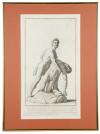 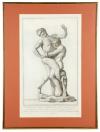 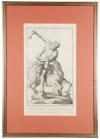 |
FERDINANDO GREGORI: A SERIES OF SIX MATCHING FLORENTINE 17TH / 18TH CENTURY COPPER ENGRAVINGS OF SCULPTURES AFTER DRAWINGS BY ANTONIO FEDI AND OTHERS
depicting classical and renaissance sculptures in Rome and Florence: 1) Laocoön in the Belvedere Courtyard, Vatican; 2) 'ancient Greek', Ajax group, Loggia dei Lanzi, Florence; 3) Hercules & the Hydra by Baccio Bandinelli, Palazzo Niccolini, Florence; 4)Hercules & Antaeus by Vincenzo de Rossi, Palazzo della Signoria, Florence; 5) Hercules & a Centaur by Giambologna, Loggia dei Lanzi, Florence; 6)Hercules & Iole with Cupid, by Domenico Pieratti, Casa Galli-Tassi, Florence, three engravings framed, three unframed,
60cm high x 43cm wide excluding frames, (6)
£600-£800
|
|
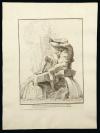 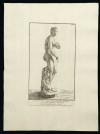 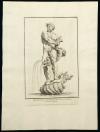 |
FIVE ENGRAVINGS AFTER BERNINI'S STATUES FROM THE FOUNTAIN OF THE FOUR RIVERS AND THE FOUNTAIN OF THE MOOR IN PIAZZA NAVONA, ROME
by Francesco Aquila, for Domenico Rossi at Santa Maria della Pace, Rome; and of the Venus de'Medici, by F. Andriot, Rome,
(49cm x 36cm),
(6)
£200-£300
|
|
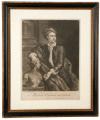 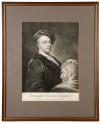 |
PORTRAITS IN MEZZOTINT ENGRAVINGS OF THE TRIUMVIRATE OF GREAT 'ENGLISH' SCULPTORS OF FLEMISH ORIGIN FROM VARIOUS SOURCES
comprising: Grinling Gibbons (1648-1721), measuring a cast of the head of Bernini's Daphne, by J. Smith, after Godfrey Kneller (34cm x 26cm), Trinity Fine Art, London, Dec. 1999, no. 33, Laurent Delvaux (1696-1778), by Alexander Vanhauken, after Isaac Whood, 1735 (36cm x 26cm), framed and glazed (53cmx 43cm), Michael Rysbrack (1694-1770), J. Faber after J. Vanderbank, 1734 (37cm x 27cm), framed and glazed (51cm x 42cm),
(3)
£600-£800
|
|
| |
A SERIES OF 18TH CENTURY FRENCH MOUNTED ENGRAVINGS OF GREAT SCULPTORS BY VARIOUS ARTISTS
from the exhibition 'Portraits of Artists and Related Subjects' at Trinity Fine Art, London, Dec. 1999, comprising, Nicolas Coustou (1658-1733) by C. Dupuis, 1730, after J. Legros's painting of 1722, etching with engraving (400 x 282 mm; no. 24); Martin van den Bogaert called Desjardins (1637-1694) by G. Edelinck after Hyacinthe Rigaud, etching with engraving (466 x 353mm; no. 26); François Girardon (1628-1715) by P. Drevet, after J. Vivien, etching with engraving (484 x 363; no. 35); La Sculpture, a sculptor contemplating his bust of King Louis XV, by M.-M. Igonet, 1751, after J.-B.-M. Pierre, engraving (375 x 268mm; no. 104); with one from a different source, Antoine Coysevox, by Jean Audran, as his morceau de Réception at the Académie Royale in 1708 (37 x 26cm [sight]), framed and glazed (55.5 x 44.5),
(5)
£800-£1,200
|
|
| |
A VERY RARE AND IMPORTANT DOCUMENTARY COLLECTION OF PORTFOLIOS WITH ORIGINAL ART PHOTOGRAPHS FROM THE 1920'S BY CLARENCE KENNEDY
of Florentine Renaissance sculpture by Desiderio da Settignano and colleagues, each of 4 portfolios containing approximately 60 large numbered photographs (complete), these are numbered '55' on the printed contents pages, being part of a limited edition of 57.
Clarence Kennedy: Studies in the History and Criticism of Sculpture: vol 2, The tomb of Carlo Marsuppini, 1928; vol. 3, Certain Portrait Sculptures of the Quattrocento, 1928;; vol. 5, The Tabernacle of the Sacrament, 1929; vol. 6, The Magdalen and Sculptures in Relief, 1929, (all) Northampton, Massachusetts, Smith College.
Kennedy's original gelatin silver prints on Athena paper from the Eastman Kodak Company in portfolios
50cm x 31cm. Sold as viewed. (4)
£2,000-£3,000
|
|

|
A VERY RARE AND IMPORTANT DOCUMENTARY COLLECTION OF PORTFOLIOS WITH ORIGINAL ART PHOTOGRAPHS FROM THE 1920'S BY CLARENCE KENNEDY (EXPERT ART-HISTORIAN) OF GREEK SCULPTURE
each of the two portfolios containing approximately 60 large numbered photographs (complete): only 25 copies of these volumes were printed, Clarence Kennedy: Studies in the History and Criticism of Sculpture (The two volumes comprising Classical sculpture): vol. 1, Pt. 1, Three Greek Bronzes; Pt. 2, The Erechtheion, 1928; vol. 4 The Treasury of the Siphnians at Delphi, 1929. Northampton, Massachusetts, Smith College, Kennedy's original gelatin silver prints on Athena paper from the Eastman Kodak Company in portfolios,
50cm x 31cm. Sold as viewed. (2)
£1,000-£1,500
The following seven lots have been in the same family for a generation and were purchased at various country house auction sales during the 1960's and 1970's.
|
|
 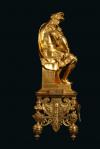 |
A RARE THIRD QUARTER 19TH CENTURY FRENCH GILT BRONZE, SILVERED AND ENAMELLED FIGURAL CLOCK BY FERDINAND BARBEDIENNE (1810-1892), LOUIS CONSTANT SEVEN (1821-1888) AND DESIRE ATTARGE (1820-1878), PARIS
the movement stamped 'JAPY FRERES' and 'LEFEBVRE & FILS PARIS'
the clock surmounted by a bronze figure of Lorenzo de' Medici after Michelangelo, raised on an ornate plinth base, signed to the left side 'C. SEVIN. IN. 1877', signed to the front 'F. BARBEDIENNE PARIS' and to the right side 'D. ATTARGE FLT', the reverse of the figure stamped with 'REDUCTION MECHANIQUE A. COLLAS BREVETE' pastille mark, the side of the figure signed 'F. BARBEDIENNE FONDEUR', the dial with enamelled decoration and a central silvered mask, the twin train movement with platform escapement striking on a bell,
59cm high
This important clock is a rare collaboration between five of the most prestigious names in French bronze art and clock making from the second half of the 19th century. The case was produced in the workshop of Ferdinand Barbedienne after a design by Constant Sevin and finished by the silversmith Desire Attarge, and the clock movement was made by Japy Freres, one of the best makers during this period. Barbedienne and Sevin worked together over thirty years from 1855 to 1888 and much of Barbedienne's success was arguably due to the high quality, inventive models developed by Seven during this time. They exhibited together at the Paris Exposition Universelle in 1867 and 1878.
In 1878 they exhibited a large gilt bronze neo-Renaissance clock and so we know that they shared a stand at this exposition which included clocks in the Renaissance taste (such as the present example). The present clock is fully signed, of the highest quality, large and decorative, dated 1877 (the year before the Paris Exposition) and also in the Renaissance taste and so further research might establish whether it was also exhibited at this time.
Other collaborations between these master makers include a monumental mirror dated 1878, now in the Metropolitan Museum of Art, New York, which also features decoration of Michelangelo-esque reclining semi-clad figures that are similar to those visible in the present piece. The original model for this mirror was made in 1867 and was exhibited by Barbedienne at the Paris Exposition Universelle of 1867. There is also a silver gilt ewer by Barbedienne, Sevin and Attarge dated 1875 in the Metropolitan Museum. A silver rhyton also by the same makers is in the Musee d'Orsay, and so it seems reasonable to suggest that the present clock may have been produced for the Exposition Universelle of 1878.
£1,000-£1,500
|
|

|
A LARGE THIRD QUARTER 19TH CENTURY FRENCH BRONZE FIGURAL CLOCK BY MIROY A PARIS
surmounted by a figure of Christopher Columbus seated on a coil of rope with an anchor at her feet, on a breakfront plinth above six paw feet, the white enamelled dial signed 'MIROY FRES PARIS', with Roman numerals, the twin train movement also stamped 'MIROY FRES PARIS GM SGDG', striking on a bell,
59cm high
£400-£600
|
|

|
A LATE 19TH CENTURY FRENCH MAHOGANY AND GILT BRONZE MOUNTED MANTEL CLOCK
the movement by Samuel Marti & Cie,
the bell top surmounted by a swing handle and flanked by four finials, on a plinth base above four toupie feet, the white enamelled dial decorated with floral garlands, the stamped twin train movement striking on a gong, with later lever platform escapement,
33cm high
This lot is sold subject to CITES regulations.
£300-£500
|
|

|
A LATE 19TH CENTURY FRENCH BOULLE STYLE TORTOISESHELL, CUT BRASS AND GILT BRONZE MOUNTED CLOCK
the movement stamped 'BARILETT DEMONTABLE BREVETE SGDG' and 'SONNERIE PROGRESS SGDG'
of typical balloon form, with scrolling acanthus mounts, the twelve piece enamelled dial with Roman numerals, the twin train movement striking on a gong, with pendulum,
30cm high
£400-£600
|
|

|
CLIVEDEN PROVENANCE: A LARGE PAIR OF 19TH CENTURY SATSUMA VASES
of baluster form, decorated with flowers and birds on a cream ground, with gilt decoration, raised on domed feet,
61cm high (2)
Provenance: Purchased by the present owner's father at the Important Sale by auction of Furniture and Effects from Cliveden, May 15 -19 1967, Phillips, Son and Neale, lot 293.
£200-£300
|
|
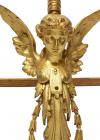  |
A LATE 19TH CENTURY FRENCH GILT BRONZE AND VERDE ANTICO FIGURAL WALL BRACKET / CONSOLE TABLE
the demi-lune marble with a gilt foliate border, the support modelled as a winged classical female caryatid hung with a garland of tailing bell flowers,
38cm high x 62cm wide
Provenance: Purchased by the present owner's father at the sale of Chelwood, London, May 15 1972, Phillips, lot 110.
£300-£500
|
|

|
A SCRATCH BUILT WOODEN MODEL OF A MAN O' WAR
the fully rigged ship with linen sails and with shields displaying the double headed eagle crest,
72cm high
£300-£500
|
|

|
A LATE 19TH CENTURY FRENCH EGYPTIAN REVIVAL ARDENNES GREY MARBLE, SLATE AND BRONZE CLOCK GARNITURE BY A. ECALI, PALAIS ROYALE, PARIS
the case of plinth form, modelled as the base of a pyramid, decorated with incised gilt hieroglyphs, the base decorated with a silvered scarab, the case surmounted by a bronze and parcel gilt model of a sphinx, the 4" signed dial with Roman numerals, the twin train movement striking on a gong, the garniture obelisks with conforming decoration, with pendulum and winder,
the clock 43cm high, the obelisks 50cm high, (3)
£1,200-£1,800
|
|

|
AN EARLY 19TH CENTURY FRENCH ROUGE GRIOTTE MARBLE AND GILT BRONZE MOUNTED PORTICO CLOCK BY BOSSET (PARIS, 1807-1823)
raised on four Doric columns above a rectangular plinth base and ball feet, the white enamelled dial signed 'Bosset a Paris' and with Arabic numerals and minute markers, the twin train movement with large outside countwheel striking on a bell, together with a pair of Napoleon III matched candelabra with six lights, stamped 'H' to one drip pan,
the clock 50cm high, the candelabra 62cm high, (3)
£3,000-£5,000
|
|

|
A THIRD QUARTER 19TH CENTURY FRENCH ROUGE GRIOTTE MARBLE, CHAMPLEVE ENAMEL AND GILT BRONZE MOUNTED CLOCK GARNITURE BY LA COMPAGNIE DES MARBRES ET ONYX D'ALGERIE AND JAPY FRERES
the plinth case surmounted by a twin handled urn, raised on paw feet, the twelve piece Roman dial signed 'MARBRES ONYX D'ALGERIE, PARIS', the twin train movement striking on a bell and stamped 'Japy Freres', with pendulum, the conforming garniture urns with removable enamelled lids with finials above,
the clock 46cm high, the urns 32cm high (3)
£2,500-£3,500
|
|

|
A LATE 19TH CENTURY FRENCH RENAISSANCE REVIVAL GILT BRONZE MANTEL CLOCK
the arched case surmounted by a twin handled urn and with a pair of free standing columns, on a plinth base above four paw feet, with acanthus scrolls and panther masks throughout, the twelve piece enamel dial with Roman numerals and signature plate (now indistinct), the twin train movement stamped 'GF', striking on a gong, the reverse of the case also finely decorated with scrolling foliage, with pendulum,
53cm high
£1,200-£1,800
|
|

|
A LATE 19TH CENTURY FRENCH GILT BRONZE AND PORCELAIN MANTEL CLOCK BY S. MARTI & CIE
the case surmounted by an urn with classical term handles and a winged finial modelled as Cupid with a torch, the porcelain panels decorated to resemble cloisonne enamel, the base with fluted and egg and dart border, the dial with Roman numerals, the twin train movement striking on a bell, with pendulum,
58cm high
£3,000-£5,000
|
|

|
A MID 19TH CENTURY FRENCH GILT BRONZE ROCOCO REVIVAL MANTEL CLOCK BY VINCENTI & CIE
the case ornately decorated with scrolling acanthus leaves, rocailles, C scrolls and trellis work, the white enamel dial with Roman numerals and Arabic minute markers, the twin train movement with outside countwheel striking on a bell,
48cm high
£4,000-£6,000
|
|

|
A LATE 19TH CENTURY FRENCH GILT BRONZE MANTEL CLOCK BY VINCENTI & CIE
the arched case surmounted by a swagged urn, the plinth base decorated with fruiting swags, anthemion and a pair of wined female caryatids, the white enamel dial with Roman numerals, centred by the Brocot escapement (invented by Achille Brocot (1817-1878) in Paris around 1860), the twin train stamped movement striking on a bell, with pendulum,
53cm high
£2,500-£3,500
|
|

|
AN IMPRESSIVE EARLY 19TH CENTURY FRENCH WHITE MARBLE AND GILT BRONZE MOUNTED MANTEL CLOCK
of arched form, surmounted by a pair of putti amongst clouds, with a pair of columns with relief floral garlands, above a beaded plinth base, the white enamelled dial with Arabic numerals, the twin train movement with outside countwheel striking on a bell, with sunburst and classical mask pendulum visible through the bevelled glass front panel,
62cm high
£2,000-£3,000
|
|

|
A LATE 19TH CENTURY FRENCH BELGIAN BLACK MARBLE AND SPELTER FIGURAL MYSTERY CLOCK
the plinth case surmounted by a figural group of Venus and Cupid in the manner of Falconet, Venus holding aloft the pendulum with ornate gilt and glass bob, the dial with Roman numerals, the twin train movement stamped 'SGDG BREVETE GLT' with outside countwheel striking on a bell,
59cm high
£2,000-£3,000
|
|

|
A LARGE FIRST HALF 19TH CENTURY FRENCH GILT AND PATINATED BRONZE FIGURAL MANTEL CLOCK DEPICTING EUROPA AND THE BULL
in the Rococo style, the case decorated with floral garlands and rocailles, and ornamented with three maids holding flowers, the bull supporting the clock case, raised on a naturalistic base, the twelve piece enamel dial with Roman numerals, the twin train movement with outside countwheel and silk suspension, striking on a bell,
67cm high
£4,000-£6,000
|
|

|
A THIRD QUARTER 19TH CENTURY FRENCH GILT AND PATINATED BRONZE ELEPHANT CLOCK IN THE ROCOCO REVIVAL STYLE
the movement by Japy Freres, modelled as an elephant carrying an Oriental figure holding a parasol, raised on a Rococo base ornamented with foliage, shellwork, rocailles and C scrolls, the twelve piece enamel dial with Roman numerals, the twin train movement with outside countwheel striking on a bell, stamped 'Japy Freres G Med d'Honneur', this stamp was in use between 1867 and 1873, with pendulum,
56cm high
£3,000-£5,000
|
|

